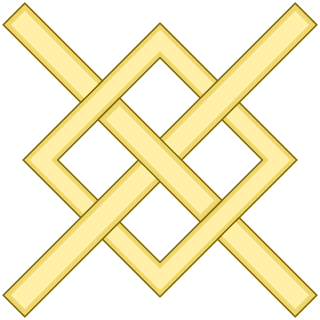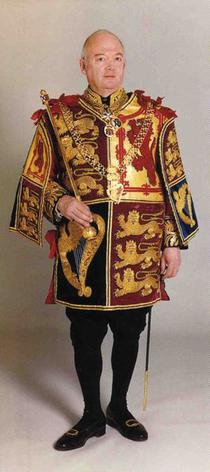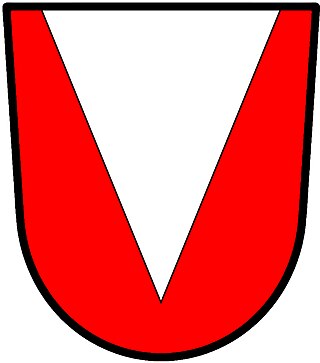
The fleur-de-lis, also spelled fleur-de-lys, is a lily that is used as a decorative design or symbol.

The Arms of Canada, also known as the Royal Coat of Arms of Canada or, formally, as the Arms of His Majesty the King in Right of Canada, is the arms of dominion of the Canadian monarch and, thus, also the official coat of arms of Canada. In use since 1921, it is closely modelled after the royal coat of arms of the United Kingdom, with French and distinctive Canadian elements replacing or added to those derived from the British version.

Norroy and Ulster King of Arms is the provincial King of Arms at the College of Arms with jurisdiction over England north of the Trent and Northern Ireland. The two offices of Norroy and Ulster were formerly separate. Norroy King of Arms is the older office, there being a reference as early as 1276 to a "King of Heralds beyond the Trent in the North". The name Norroy is derived from the French nort roi meaning 'north king'. The office of Ulster Principal King of Arms for All-Ireland was established in 1552 by King Edward VI to replace the older post of Ireland King of Arms, which had lapsed in 1487.

Arundel Herald of Arms Extraordinary is a supernumerary Officer of Arms in England. Though a royal herald, Arundel is not a member of the College of Arms, and was originally a private herald in the household of Thomas Fitzalan, Earl of Arundel. The first herald, John Cosoun, is known to have served the Earl both in Portugal in 1413 and later in France, where he attended his dying master in October 1415. The title was revived in 1727 as Herald Extraordinary.

Maltravers Herald of Arms Extraordinary is a current officer of arms extraordinary in England. As such, Maltravers is a royal herald, but is not a member of the College of Arms in London. The present office was created in 1887 by the Earl Marshal, who was also the Duke of Norfolk and Baron Maltravers. The office is known to have been held by a pursuivant to Lord Maltravers when he was deputy of Calais from 1540 to 1544. The badge is blazoned as A Fret Or. It was officially assigned in 1973, though it had been assumed by two Maltravers Heralds in the 1930s. It derives from the coat of arms of Maltravers Sable a Fret Or and a Label of the points Ermine, and was the badge of John, Earl of Arundel through which family the barony passed to the Howard dukes of Norfolk.

Wales Herald of Arms Extraordinary is a current Officer of Arms Extraordinary under the Courts of England and Wales' jurisdiction. Wales is a Royal Herald, ie a member of the Royal Household, and while not being a member of chapter of the College of Arms, processes with the other heralds at ceremonial occasions. Wales Herald forms an integral part of the procession when the British monarch officially opens a session of Senedd Cymru at Cardiff Bay.

Norfolk Herald of Arms Extraordinary is an officer of arms in England. As an officer extraordinary, Norfolk is a royal herald, though not a member of the corporation of the College of Arms in London. Beginning in 1539 this officer was a herald to the dukes of Norfolk, though the first holder, John James, was paid a salary by King Henry VIII. Subsequent Norfolk heralds have been officers extraordinary, though the office has not always been filled but rather revived when required. The badge of office, assigned in 1958, is blazoned as Two Ostrich Feathers saltirewise each charged with a Gold Chain laid along the quill. It derives from the ostrich feather badge granted by King Richard II around 1387 as a mark of special favor to Thomas Mowbray, Duke of Norfolk, Marshal of England. Mowbray was also the first to be styled Earl Marshal.

Fitzalan Pursuivant of Arms Extraordinary is a current officer of arms in England. As a pursuivant extraordinary, Fitzalan is a royal officer of arms, but is not a member of the corporation of the College of Arms in London. As with many other extraordinary offices of arms, Fitzalan Pursuivant obtains its title from one of the baronies held by the Duke of Norfolk, Earl Marshal of England; the appointment was first made for the coronation of Queen Victoria in 1837. The badge of office was assigned in 1958 and is derived from a Fitzalan badge of the fifteenth century. It can be blazoned An Oak Sprig Vert Acorns Or, but is also recorded as A Sprig of Oak proper.

John Philip Brooke Brooke-Little was an English writer on heraldic subjects, and a long-serving herald at the College of Arms in London. In 1947, while still a student, Brooke-Little founded the Society of Heraldic Antiquaries, now known as the Heraldry Society and recognised as one of the leading learned societies in its field. He served as the society's chairman for 50 years and then as its president from 1997 until his death in 2006.

Surrey Herald of Arms Extraordinary was an English officer of arms. Though an officer of the crown, Surrey Herald Extraordinary was not a member of the corporation of the College of Arms in London. This office was created in 1856 and first held by Edward Stephen Dendy. The badge of office was assigned in 1981. The badge is blazoned Within a representation of a Herald's Collar of SS Argent a Tabard chequy Or and Azure. These were the arms of John de Warenne, Earl of Surrey in the late thirteenth century, from whom the earldom descended through the Fitzalans to the Howard dukes of Norfolk and earls marshal.

Francis Sedley Andrus LVO was a long-serving English officer of arms who was Beaumont Herald of Arms Extraordinary. As such, he was a Royal officer of arms, though not a member of the College of Arms in London.
Edward Bellasis (1852–1922) was a long-serving officer of arms at the College of Arms in London. He was the son of another Edward Bellasis, a serjeant-at-law. His heraldic career began in 1873 when he was appointed Bluemantle Pursuivant of Arms in Ordinary. In 1882, he was promoted to the office of Lancaster Herald of Arms in Ordinary. He held this post for forty years until his death in 1922. Bellasis used a coat of arms inherited from his father. The arms were blazoned Argent a Chevron between three Fleurs-de-lis Azure in chief a Tent Purpure lined Gules.

The American College of Heraldry and Arms, Inc. was an American organization established in 1966 to promote heraldry in the United States. The corporate address of the college was Harbormaster's Building, Herald's Mews on Longneck, Pier 4 Pratt Street, Baltimore, Maryland.
Blanche Lyon Pursuivant of Arms in Ordinary was an English office of arms created during the reign of King Edward IV.
Thomas Shaun Stanage was bishop of Bloemfontein in the Anglican Church of Southern Africa from 1982 to 1997.
John Mynne was an English officer of arms. He was the son of Henry Mynne of Gloucestershire, and son-in-law of John Writhe, the Garter King of Arms from 1478 to 1504.

In heraldry, a pile is a charge usually counted as one of the ordinaries. It consists of a wedge emerging from the upper edge of the shield and converging to a point near the base. If it touches the base, it is blazoned throughout.

Jessant-de-lys is a heraldic term denoting a fleur-de-lys issuing out of any object. It is most frequently seen in conjunction with a leopard's face, meaning in heraldic language the face of a lion.

Howard Pursuivant of Arms Extraordinary was an officer of arms extraordinary in England; that is, a royal herald but not a member of the College of Arms in London.

The coat of arms of Beverwijk is a coat of arms that has been renewed several times. The coat of arms of Beverwijk is the only coat of arms of a Dutch municipality that is surrounded by a cloak. This is highly unusual in the Netherlands, where such a cloak is normally reserved for nobility, the pope and national coats of arms.


















